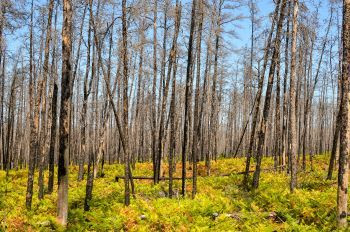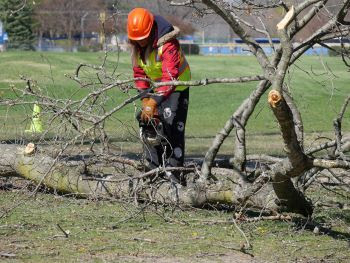

|
A family forest is an investment that can create an outdoor legacy for future generations, but wildfire, storms, drought and hungry insects all can threaten forest lands.
The Emergency Forest Restoration Program from the U.S. Department of Agriculture is available for landowners in case of catastrophic damage to private, nonindustrial forests.
“This little-known resource available through our federal partners is one that Michigan forest owners should be aware of,” said Mike Smalligan, DNR Forest Stewardship Program coordinator.
The program is offered through the USDA Farm Service Agency and can cover up to 75% of the costs to restore lands after windstorms, wildfire or other damage.
In fall 2019, Michigan’s Arenac County on the north side of Saginaw Bay suffered a wind shear event that threw trees to the ground with tornadolike force. Local USDA Farm Service Agency employees applied for an Emergency Forest Restoration Program cost-share sign-up at the request of local landowners who suffered damage.
Once sign-up was open, 28 applications for EFRP cost share were accepted, providing over $410 thousand in cost-share assistance to restore nearly 400 acres of damaged forest. With technical assistance from DNR service foresters, staff prepared restoration plans for the landowners and helped them through the process to receive reimbursement.
“After the storm, we met with a young woman who spent tens of thousands in savings to help restore her aging parents’ family forest,” said DNR service forester Mike Hanley. “The Emergency Forest Restoration Program reimbursed half of her costs – she was incredibly relieved when we gave her the news.”
|
The program also was used to assist eastern Upper Peninsula landowners after the destructive Duck Lake Fire in 2012. The fire blazed over more than 21,000 acres of forest land, prompting evacuations and causing millions of dollars in damage to homes and property. |
The Emergency Forest Restoration Program provides payments to owners of nonindustrial private forest land for emergency restoration measures to lands damaged by natural disaster. Eligible practices include:
|
After a disaster, Farm Service Agency committees determine program eligibility with on-site inspections to assess the type and extent of damage.
“To be eligible for support, the damage must be significant, and there needs to have been existing tree cover on the landscape before the natural disaster,” said Farm Service Agency conservation chief Dale Allen. “Only privately owned, nonindustrial forest lands are eligible.”
Cost-share payments are determined by committee. They can be up to 75% of the cost to implement approved restoration practices and are limited to $500,000 per person, per disaster.